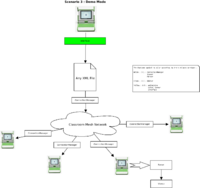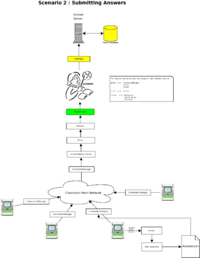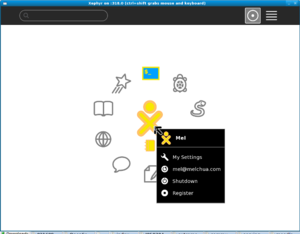Difference between revisions of "Educational Toolkit"
Deepankgupta (talk | contribs) |
Deepankgupta (talk | contribs) |
||
| Line 71: | Line 71: | ||
'''''Specifications''''' | '''''Specifications''''' | ||
| − | # '''Individual Test Distribution Story''' : [[System_dia.png]] | + | # '''Individual Test Distribution Story''' : [[Image:System_dia.png|200px|thumb|right|System Diagram]] |
## A teacher shares/broadcasts the question.xml files to all the students in the class. | ## A teacher shares/broadcasts the question.xml files to all the students in the class. | ||
## The question.xml file is displayed in the Educational Toolkit GUI with all the questions rendered using the notebook Control of PyGTK. | ## The question.xml file is displayed in the Educational Toolkit GUI with all the questions rendered using the notebook Control of PyGTK. | ||
## The students work individually on the problems and the answer.xml files generated by each student are sent back to the teacher. | ## The students work individually on the problems and the answer.xml files generated by each student are sent back to the teacher. | ||
| − | + | # '''Question Generation Story''' : | |
| − | |||
| − | |||
| − | |||
| − | |||
| − | # '''Question Generation Story''' | ||
## Please note that a question does not mean an MCQ or True/False only, but can mean a general problem, a slide, fact or anything. A question specifically contains: | ## Please note that a question does not mean an MCQ or True/False only, but can mean a general problem, a slide, fact or anything. A question specifically contains: | ||
### text | ### text | ||
| Line 90: | Line 85: | ||
## Stretch Goal : Enable the user to specify rendering information through GUI. | ## Stretch Goal : Enable the user to specify rendering information through GUI. | ||
## Question.xml file will be generated. | ## Question.xml file will be generated. | ||
| − | # '''Review Answers''' | + | # '''Group Test Taking Story''' : [[Image:Edu_Toolkit_-_System_dia3.png|200px|thumb|right|System Diagram]] |
| + | ## Teacher/Student has distributed the question.xml files to all the students. The person who starts this test also forms the group i.e. sends an invite to the neibouring xos to join to form a group. | ||
| + | ## The students are sharing their activities in the form of groups. | ||
| + | ## A student marks an answer of any question. | ||
| + | ## The answer gets reflected on every student of the group i.e. it is multicasted. Two ways of doing it: Either generate an intermediate answer.xml file OR call a remote method on every person in the group using DBUS. | ||
| + | # '''Review Answers''' : [[Image:Edu_Toolkit_-_System_dia2.png|200px|thumb|right|System Diagram]] | ||
## Teacher has got 3 files : question.xml; answer.xml and student_answer.xml | ## Teacher has got 3 files : question.xml; answer.xml and student_answer.xml | ||
## The two answer files are displayed along with the question.xml to enable a teacher to review the answers of the students. | ## The two answer files are displayed along with the question.xml to enable a teacher to review the answers of the students. | ||
Revision as of 23:17, 23 March 2009
About you
Q.1 : What is your name?
Ans : Deepank Gupta
Q.2 : What is your email address?
Ans : deepankgupta [AT] gmail [DOT] com
Q.3 : What is your Sugar Labs wiki username?
Ans : deepankgupta
Q.4 : What is your IRC nickname?
Ans : deepank
Q.5 : What is your primary language? (We have mentors who speak multiple languages and can match you with one of them if you'd prefer.)
Ans : English and Hindi
Q.6 : Where are you located, and what hours do you tend to work? (We also try to match mentors by general time zone if possible.)
Ams : Located in New Delhi, India, UTC +530.
I am flexible about my work-timings and can match up with a US Timezone too since I usually stay up late at night.
Q.7 : Have you participated in an open-source project before? If so, please send us URLs to your profile pages for those projects, or some other demonstration of the work that you have done in open-source. If not, why do you want to work on an open-source project this summer?
Ans : Following are the projects I have been associated in :
- Bibliographic Reference Parsing : http://code.google.com/p/bibliographic-reference-parsing/ OR http://code.google.com/p/google-summer-of-code-2008-plazi/
- Foodforce2 : http://code.google.com/p/foodforce/
- AI Challenge : http://code.google.com/p/ai-challenge/
About your project
Q.1 : What is the name of your project?
Ans : Educational Toolkit
Q.2 : Describe your project in 10-20 sentences. What are you making? Who are you making it for, and why do they need it? What technologies (programming languages, etc.) will you be using?
a) : What are you making
The educational toolkit is a software to facilitate discussion in classroom with the help of technology. The software will aim at providing teachers and students with a tool to pose problems and then compare and discuss solutions. It can also be used as a formal testing tool for class tests and provide a better gauge of a student's progress to the teacher.
Features
- Teacher/Student makes questions. Note that a question here means a problem/slide/fact.
- Students give answers via collaboration or individually. Students split in groups and go from their individual answers to a collaborative answer
- Teacher can review all answers later
- Teacher gives individual or group feedback
Specifications
- Individual Test Distribution Story :
- A teacher shares/broadcasts the question.xml files to all the students in the class.
- The question.xml file is displayed in the Educational Toolkit GUI with all the questions rendered using the notebook Control of PyGTK.
- The students work individually on the problems and the answer.xml files generated by each student are sent back to the teacher.
- Question Generation Story :
- Please note that a question does not mean an MCQ or True/False only, but can mean a general problem, a slide, fact or anything. A question specifically contains:
- text
- answer space(or no answer space)
- images
- audio(stretch goal)
- A GUI to enable a person(teacher/student) to make a question with the above mentioned ingrediants. Note that a question can span mutiple screens also.
- No rendering information of the question needs to be provided as it will be rendered automatically.
- Stretch Goal : Enable the user to specify rendering information through GUI.
- Question.xml file will be generated.
- Please note that a question does not mean an MCQ or True/False only, but can mean a general problem, a slide, fact or anything. A question specifically contains:
- Group Test Taking Story :
- Teacher/Student has distributed the question.xml files to all the students. The person who starts this test also forms the group i.e. sends an invite to the neibouring xos to join to form a group.
- The students are sharing their activities in the form of groups.
- A student marks an answer of any question.
- The answer gets reflected on every student of the group i.e. it is multicasted. Two ways of doing it: Either generate an intermediate answer.xml file OR call a remote method on every person in the group using DBUS.
- Review Answers :
- Teacher has got 3 files : question.xml; answer.xml and student_answer.xml
- The two answer files are displayed along with the question.xml to enable a teacher to review the answers of the students.
- A marks.xml file is generated if teacher wishes to give numerical marks. Though this feature is subject to discussion. Since, this software does not want to promote the current examination system of awarding marks in tests. We have already seen a lot of suicides by students after scoring less marks who were under tremendous peer/teacher/parent pressure to advocate it
b) : Who are you making it for
Primary, Secondary and Higher Secondary Students and Teachers.
The students will use it for the following:
- Self Revision
- Answering class tests.
- Group problem Solving.
The teachers will use it for the following:
- Enabling Classroom Discussion
- Teach children to solve problem in groups.
- Monitor and impact the student's learning.
c) : Why do they need it
It aims to act like a tool which does not take over the job of teaching, but promotes natural class environment and will aim to fit in the classroom environment. The software promotes better examination methods and encourages group work which is vital in any learning environment.
d) : What technologies (programming languages, etc.) will you be using?
The software is being developed in Python with emphasis on easy User Interface. The software will use : PyGTK for User Interface; Telepathy and DBus Tubes for connectivity; XML DOM API for xml
Q.3 : What is the timeline for development of your project? The Summer of Code work period is 7 weeks long, May 23 - August 10; tell us what you will be working on each week. (As the summer goes on, you and your mentor will adjust your schedule, but it's good to have a plan at the beginning so you have an idea of where you're headed.) Note that you should probably plan to have something "working and 90% done" by the midterm evaluation (July 6-13); the last steps always take longer than you think, and we will consider cancelling projects which are not mostly working by then.
Ans : TODO: Make a timeline after discussions
Q.4 : Convince us, in 5-15 sentences, that you will be able to successfully complete your project in the timeline you have described. This is usually where people describe their past experiences, credentials, prior projects, schoolwork, and that sort of thing, but be creative. Link to prior work or other resources as relevant.
Ans : I can work on the project in the given timeline, since the technology is there and I can give sufficient time over the summers. The work being proposed is not unreachable or require resources which I won't have access to. Thus, I see no reason why I should fail to complete the project.
TODO: Try to make above para more convincing.
I have also got some experience of coding. Particularly:
- I have been a part of GSoC 2008 as a student in Plazi.
- Two internships at Microsoft in the Office Mobile Division. Worked on the build system for Office Mobile and developed and implemented a sync story for exchange mails and tasks.
- Worked on development and project management of Foodforce which is an activity for Sugar, runs on Windows and Linux platforms too.
- Worked on PCard and UnoLipi.
- Developed and organised Linux Challenge and AI Challenge during technical fests. Been a winner at Linux Challenge, Technical Paper Presentation, Open Software Display in various colleges. ACM ICPC Regional contest participant.
You and the community
Q.1 : If your project is successfully completed, what will its impact be on the Sugar Labs community? Give 3 answers, each 1-3 paragraphs in length. The first one should be yours. The other two should be answers from members of the Sugar Labs community, at least one of whom should be a Sugar Labs GSoC mentor. Provide email contact information for non-GSoC mentors.
Ans :
If the project is successfully completed, one more piece of the puzzle will fall in place. The "Education Through Computers" Story remains incomplete without an activity like Educational Toolkit. We need to make sure that Children not only learn to read (Read Activity), google(Browse Activity), entertain(Foodforce, Maze etc.), write(Write & Chat activity); but also collaborate and do problem solving. Any learning is incomplete without testing; much like no software is ship-quality without proper testing and code coverage. - Me
There was a nice project done in Chile using Ipacks: the "teacher" would pose a problem and the children would formulate an answer. Then they'd gather in groups of four and pool their answers. Each group of four would then reach consensus on an answer they thought was correct. All of the group answers would be shared with the entire class. Then a class discussion would ensue: why did Group A come up with that answer? The role of the computer and the teacher was to facilitate the discussion among the students and to focus discussion around problem areas that revealed themselves in discussion. A nice use of collaboration that has nothing to do with taking control or "all eyes forward". - Walter Bender
TODO: Get one more paragraph
Q.2 : Sugar Labs will be working to set up a small (5-30 unit) Sugar pilot near each student project that is accepted to GSoC so that you can immediately see how your work affects children in a deployment. We will make arrangements to either supply or find all the equipment needed. Do you have any ideas on where you would like your deployment to be, who you would like to be involved, and how we can help you and the community in your area begin it?
Ans : I would like the deployment to be at my old school since I have good relations with my teachers and principal there. I will approach them about the pilot project and will love to be involved in the pilot.
Q.3 : What will you do if you get stuck on your project and your mentor isn't around?
Ans : I will do the following things in the same order:
- Google.
- Ask on IRC a specific query.
- Again Google and make the query specific in case it is not resolved or people don't respond.
- Ask on mailing list.
Q.4 : How do you propose you will be keeping the community informed of your progress and any problems or questions you might have over the course of the project?
Ans : I will do the following things :
- Write about it on my blog : http://deepank.blogspot.com (1 or 2 posts/week)
- Update WIKI Page with Progress (when a milestone reached)
- Problems/Questions : IRC and Mailing Lists.
Miscellaneous
- We want to make sure that you can set up a development environment before the summer starts. Please send us a link to a screenshot of your Sugar development environment with the following modification: when you hover over the XO-person icon in the middle of Home view, the drop-down text should have your email in place of "Restart." See the image on the right for an example. It's normal to need assistance with this, so please visit our IRC channel, #sugar on irc.freenode.net, and ask for help.
- What is your t-shirt size? (Yes, we know Google asks for this already; humor us.)
- Describe a great learning experience you had as a child.
- Is there anything else we should have asked you or anything else that we should know that might make us like you or your project more?



